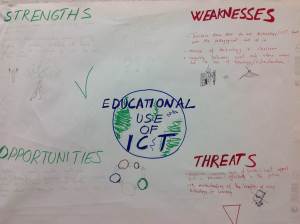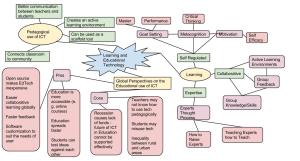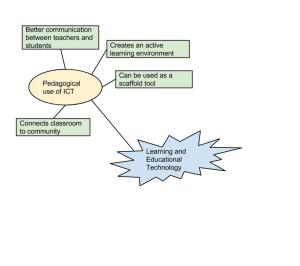A week or so ago I had the privilege of attending the UBIKO (which stands for ubiquitous technology enhanced learning) school in Oulu with my classmates.
UBIKO – for those of you that don’t know – is a pedagogical development project that uses many approaches in order to adapt school life to the needs of 21st century learning. The UBIKO project seeks to: develop the curriculum, find effective methods to promote self-regulation in primary school pupils, develop teamwork among teachers and enrich multi-locational learning in school context.
Question 1: How do you perceive/see the UBIKO environment?
As someone who is very much a novice teacher, I believe my original perceptions of the UBIKO environment would of been very shallow if it wasn’t for the pamphlet and presentation we were given. It was only due to the guidance and teaching of an expert that I was able to see all the underlying changes to traditional school life and understand what their purpose was.
However, after following up the tour with self study at home, I feel confident that I can somewhat analyze the changes to the traditional school environment made by the UBIKO program.
The first thing I noticed was that there were many communal places in the school: there was a ship filled with cushions where the students were able to sit in groups comfortably, there were also two more traditional rooms that contained a circular table with chairs and, finally, in the classrooms the desks were able to be easily rearranged into whatever order the students wished them to be. Hence, due to the many communal places at hand, the students are given many opportunities to think and reason together in environments that they find the most stimulating (which promotes co-regulation).
Secondly, I realized that students were actually given a lot of choice when it came to learning. Not only were they able to choose the location and modify the environment, but they were also able to choose whether they wanted to work in pairs, groups or alone in a technology enhanced environment (which promotes socially shared regulation).
Finally, something that I found really interesting, was how the emphasis on the teachers’ role in supporting the pupils’ self-regulation processes – rather than merely traditionally teaching facts at the front of the class.
Personally, as someone who was taught in a traditional manner, it was easy to notice the changes that were present in the UBIKO school. Although my original understanding of how the changes could benefit the students was pretty shallow – after guidance and self study I feel that I am better able to evaluate learning environments.
For example, when evaluating learning environments, I must pay attention to the extent with which students are able to modify and shape their environment (which supports the promotion of SRL), their opportunities to work collaboratively together (shared regulation) and how easily/effectively students can receive feedback/help on their work (teachers fostering self-regulation). If I can see that the learning environment is meeting such criteria, I would be able to suggest that students’ SRL was being facilitated. Due to this, the students’ future learning in higher education might improve as they would become better self-regulated learners than those taught with only traditional methods.
Question 2: How are the UBIKO ideas transferable to other context? Choose the context.
It is important to mention, as Bransford and Schwartz (1999) highlight, that previous knowledge learned is not always directly applicable to other contexts. We must do more that simply replicate knowledge (“knowing that”) or apply knowledge (“knowing how”) to new contexts – we must think, perceive and judge with everything that we have learned before when faced with a new problem (“knowing with”). Therefore, it would be erroneous of me to directly apply the UBIKO ideas to a different context. However, I can use what I have learned from the UBIKO program to help me approach other problems.
For example, I could use the ideas of the UBIKO project to tackle a problems in a work place context. I could consider how UBIKO provided many different places for students to work together collaboratively (promoting co and shared regulation) and then see if the same approach (providing multiple places for people to meet) would also work in helping to promote a good community amongst work colleagues.
Another example, could be allowing workers to construct/modify their working environment. By doing this we could see if it has any affect on the quality of work being produced, the speed with which the work is produced or the happiness of employees (much in the same way that allowing a flexible environment promotes SRL in students).
Final Statement.
All in all I found my trip to the UBIKO school to be very enlightening. Although I am still very far away from being able to call myself an expert in such things – I feel that after my visit and following self study – I am better able to perceive what constructs a positive learning environment and how to manufacture a similar learning environment in the future (paying attention to students’ opportunities to moderate their environment and regulate their own/each others learning).
Reading:
Bransford, J. D. & Schwartz, D. L. (1999). Chapter 3: Rethinking Transfer: A Simple Proposal With Multiple Implications. Review of Research in Education, 24(1), 61–100. DOI:10.3102/0091732X024001061
Schempp, P. G & Johnson, S. W. (2006). Learning to see: Developing the perception of an expert teacher. Journal of Physical Education, Recreation & Dance, 77(6), 29–33.


